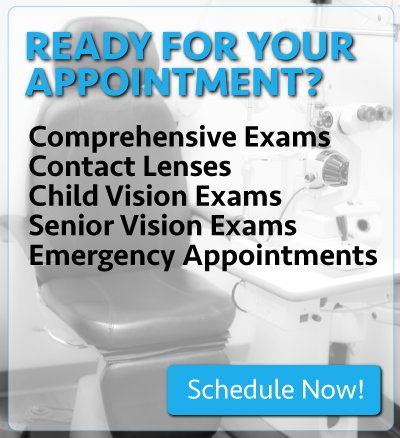Annual comprehensive ocular and visual assessments are an important part of preventative health care.
Exams are customized to each patient, factoring in age, visual needs, medical history including past and present issues, as well as detailed family history and personal risk factors.
Comprehensive Eye Exam for Adults Age 20-64
Thorough testing, in some cases over 50 tests performed, provides you with the exact current eyeglass prescription to ensure the best possible clarity of vision, as well as screening for common diseases and conditions including:
- Cataracts – a cloudy area in the clear lens of the eye behind the iris
- Glaucoma – progressive damage to the optic nerve, loss of nerve tissue that results in vision loss
- Eye Infections and Inflammation – Red Eye, Pink Eye, Contact Lens Irritation, Allergies
- Dry Eye Syndrome – insufficient lubrication
- Macular Degeneration – a disease affecting the macula (center of the light-sensitive retina at the back of the eye), causing loss of central vision
- Retinal Disorders including holes, tears and detachments – separation of the retina from the underlying tissue
Some medical and visual tests you can expect during a routine eye exam include:
Pretesting
- Auto-Refraction – assessing a refractive error estimate, provides objective measurement of refractive error and prescription for glasses or contact lenses by measuring how light changes as it enters the eye. A starting point for subjective refraction test.
- Auto-Keratometry – corneal curvature measurement. This is the shape of the front surface of the eye, for contact lens fitting and detection of certain diseases such as keratoconus, as well as a factor in determining laser surgery candidacy.
- Non-Contact Tonometry – intraocular pressure measurement – ascertains fluid pressure in the eye to detect potential onset of glaucoma.
- Previous Eye Glasses Frames Measurements – especially helpful if you like the way your past eye glasses fit your face.
Visual Acuity
- How well you see at various distances. Subjective refraction test is performed by a series of patient questions to evaluate each eye, individually and together, with and without corrective lenses.
Binocular Vision Testing
- Cover Test (eye turn – commonly referred to as ”lazy eye”)
- Stereoacuity (3D vision – depth perception)
- Accommodative or vergence function (dysfunction resulting in eye strain and/or fatigue)
Colour Vision Evaluation
- To detect if there is a color deficiency present
Slit Lamp Biomicroscopy
- Examination of the front structures of the eye, including the lids, eyelashes, cornea, conjunctiva etc.
- Assessment for dry eye syndrome and other ocular surface disease (disorders of the surface of the cornea, the transparent layer forming the front of the eye)
Pupil Dilation, Fundus Examination, and Binocular Indirect Ophthalmoscopy
- Examination of the internal structures of the eye, including optic nerve, peripheral retina, lens, vitreous etc.
At the end of each exam, patients are provided an individualized treatment plan, prescription for eyeglasses, nutriceuticals, medications if appropriate, referrals and co-management as required, and an opportunity to discuss final questions or concerns.
OHIP Eligibility is defined by the Ministry of Health and Long-Term Care. Patients aged 20 to 64 years who have any of the following medical conditions can go to their optometrist or physician and receive an OHIP insured eye examination once every 12 months : diabetes mellitus, glaucoma, cataract, retinal disease, amblyopia, visual field defects, corneal disease, strabismus, recurrent uveitis or optic pathway disease.

